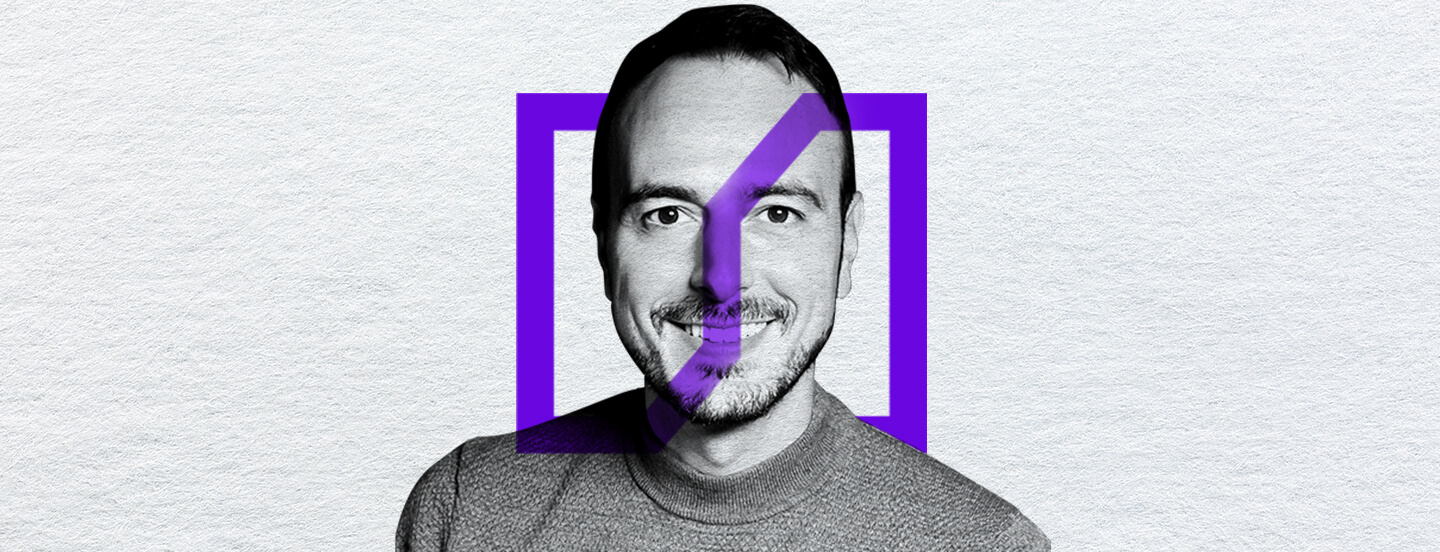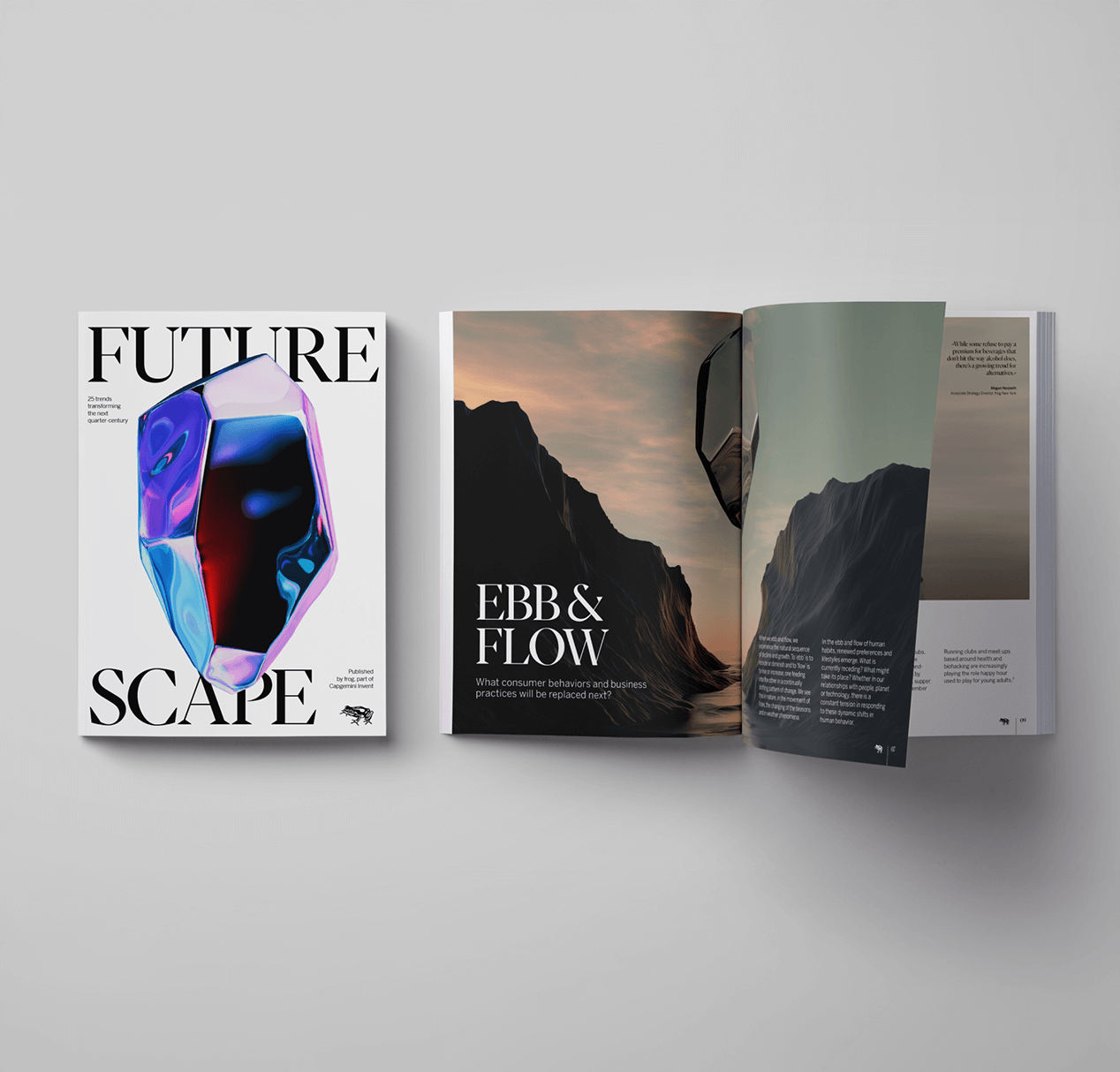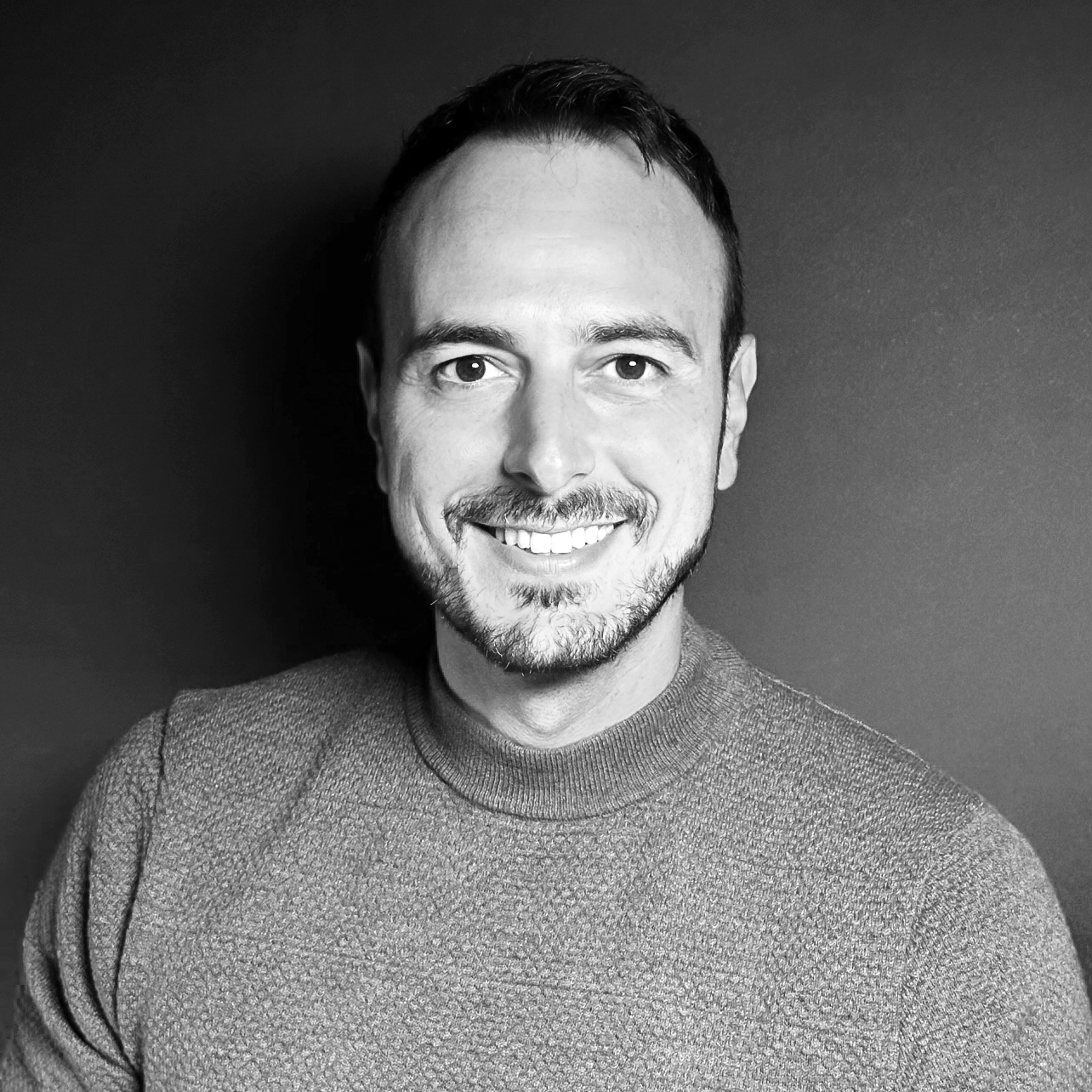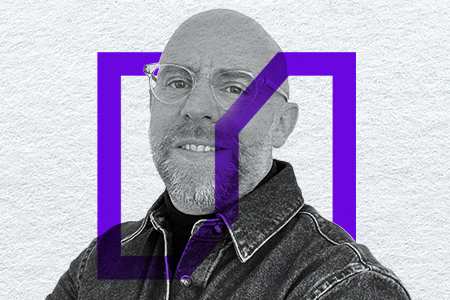
Design Mind frogcast Ep.53 – Engaging in Our Natural Language
On this episode of the Design Mind frogcast, we’re joined by Antonello Crimi, Head of Design West Coast North America at frog, to talk about the shift from app-centric to language-centric technology and the potential for natural, conversation-like interactions with devices.
Antonello shares insights on how language will be used to further integrate digital touchpoints into the physical world–and how AI and natural language processing can contribute to positive mental health outcomes. Plus, Antonello tells us how a focus on quality and attention to detail has influenced the creation of a new frog typeface that embodies the brand.
Listen to the episode below. You can also find the Design Mind frogcast on Apple Podcasts, Spotify and anywhere you listen to podcasts.
Episode Transcript:
Design Mind frogcast
Episode 53: Engaging in Our Natural Language
Guest: Antonello Crimi, Head of Design West Coast, North America, frog, part of Capgemini Invent
[00:00:03] Elizabeth Wood: Welcome to the Design Mind frogcast. Each episode, we go behind the scenes to meet the people designing what’s next in the world of products, services and experiences, both here at frog and far, far outside the pond. I’m Elizabeth Wood. Today on our show, we’re exploring the shift from an app-centric world to a language-centric future, a future where people can interact with their devices as naturally as chatting with a friend. To do this, we’re joined by our guest, Antonello Crimi, the Head of Design at frog on the west coast of North America. Antonello discusses how natural language processing can help us tear down silos, improve user journeys and even contribute to positive mental health outcomes. He also shares how a focus on quality and attention to detail has influenced the creation of a new frog typeface that truly embodies the frog brand. Here’s Antonello now.
[00:00:54] Antonello Crimi: I think in the beginning, my hope was to become an excellent designer and to reach craft excellence at pretty much any touchpoint. Anything I would touch would need to resonate the frog model, you know, is obsession with quality, excellence as a non-compromising obligation. I really believe in that and it really resonated in me when I was working as an individual contributor, as a designer, all the way to leadership. Hi, I’m Antonello Crimi. I am the Head of Design at frog on the west coast in North America.
[00:01:26] Antonello Crimi: Yeah, it’s been an interesting journey. I started my career in advertising. I was really interested when I was in university about the power of communication and storytelling, and I was really attracted by the fact that through powerful storytelling you could capture people’s attention and then get through their emotions to the core of their heart and move them and move to action. It was very interesting as an idea that I could use these powers. And at the time, I was also very interested in graphic communication. So I think the natural direction for me was getting into art direction in advertising.
[00:01:59] Antonello Crimi: I had explored a lot of the spectrum of graphic design, brand identity, corporate image, and then I got into packaging. And I think I got to a point where I started getting interested in the web design. I started working in a company that was providing a service. Web design, SEO, SEM and so on. And I think I started delving into that space. And I think this was kind of the bridge going from physical and so print and advertising and communication and graphical communication to product, it was like an interesting shift that I was not really aware of. And I think this inevitably led me to 2007, the year where the iPhone came out and realizing, Oh, wait, that is where we’re going. That’s where the world is going, and that’s the type of train I want to get on. So I think I really focused completely on product design, and I started studying interaction design, visual design and all the crafts that really would build my kind of skillset in this space.
[00:02:51] Elizabeth Wood: The release of the iPhone and the iPhone software development kit, or SDK, marked a turning point that has helped to shape how we interact with our technology and our world today. Here Antonello shares more about how this evolution took place.
[00:03:06] Antonello Crimi: So I think what happened in 2007 is the iPhone came out and it clearly showed us what the future of human computer interaction could look like. What the iPhone became was a platform or a new way of interacting with computers, and this platform was the apps. So 2009 the SDK came out, and finally, companies and developers were able to create their own products and to provide their products and services on this new platform that was all of a sudden in the hands and pockets of millions of people. So this was an interesting, revolutionary moment for companies and services to provide their products and services in a very immediate way. I think, up until that point, we were, you know, going back to our computers. We needed to go back home, or we need to have our laptops on our laps to access this world of services. But from 2009 on, that was not the case anymore. We had an internet connection on our devices, and we had everything in our palms.
[00:04:03] Antonello Crimi: And so the claim at the time was, there’s an app for that. The idea that Apple was really going for is, come here. There’s a marketplace for products and services. We have the best platform in the world. It’s undeniable that the quality experience that we can deliver is unparalleled. So come here, work with us, create all the apps that you want and use every single level of differentiation you can think of to connect with customers in a new way. And so that was the moment where we have started introducing a plethora of apps on every single device. Fast forward to today, 2025 we have been pretty much inundated with apps and products more or less useful.
[00:04:44] Antonello Crimi: But in reality, what we’re doing is again, we have been forced to communicate in machine language and machine language today because of the nature of these single businesses with their own business logics and their own desires of having more control over the customers and their data and monetizing on this attention, they want us to use their products, and they want us to be within their world, and that silo and the reality is that we have to shift and jump from one app to another, from one silo to another, something that we’ve been forced to do to accomplish anything we want. And so we cannot, quite naturally flow from one service to another and then create kind of bespoke solution for the unique and nuanced user journey to achieve what we want.
[00:05:32] Elizabeth Wood: Antonello recently contributed to frog’s Futurescape report, which explores 25 trends transforming the next quarter century and beyond. In the report, Antonello highlighted the ongoing shift from app-centric interactions to natural language-centric experiences.
[00:05:48] Antonello Crimi: We have exploded solutions into millions of apps, but that’s not our natural means of interacting. That’s not the most convenient means of interacting for human beings. A simple conversation is a much simpler and a much more natural way for people to get around their thoughts and come up with solutions and evaluate solutions.
[00:06:05] Antonello Crimi: Language is the strongest way of people of connecting with each other, interacting with each other and sharing information and get things done. That’s how humans have evolved. That was the competitive advantage of humans among all species, like a very strong capacity of communicating very small details about their thoughts, about nature, about their environment.
[00:06:27] Antonello Crimi: My dream is really that I have a direct conversation with my device, whatever that is. It’s even touch point independent, because when I start talking to a device, it can be a watch, it can be a phone, it can be a computer, it can just simply be my headphones when we get to a point where edge computing is going to be advanced enough and we’re going to be able to provide the intelligence that now we have in devices and cloud computing, so on the cloud, in one small device that can be just in our ears. And that’s probably where we’re going to be in a very different place. And I think that’s a very interesting world to think about. Imagine that I’m interacting with any of these touchpoints, and I’m just having a regular conversation, and in this conversation, I’m fundamentally building upon the previous step. I am not stating everything I want, but I’m starting having a conversation that flows as natural as a conversation with a friend.
[00:07:19] Antonello Crimi: The simplest example is planning a trip. So I’m fundamentally stating my intent. You know, next weekend, I was thinking about going for a trip in New Orleans. I’m really curious about, you know, seeing the city. What do you suggest? And then the system starts coming back at me with a number of potential solutions. And then we start breaking it down, and we go from airline booking to Airbnb or hotels, and then you started getting into more fine tuned selections about the experiences. But the beauty of all of this is that in all this conversation, the system will have a contextual knowledge about who I am, my preferences, my past experiences, the type of things I like, the type of things I don’t like, and all this data has been progressively stored over time through hours and hours of interaction. I haven’t saved this information anywhere. This is just happening as a conversation with a friend is happening, and so a friend has a clear understanding of who I am and the type of things that I that I like and that I do, and the experiences I have, and whenever they come back to me with a recommendation is because they know me fundamentally.
[00:08:22 Antonello Crimi: And of course, there are, you know, financial implications in the product recommendation. And you know, those are going to be, of course, accounted for. But I don’t have to jump from, you know, one up to another and potentially spend an hour to get to a final solution. This could be a simple conversation. Could be a five minute session. Fundamentally, the idea is that at the end of this conversation, I might either made my mind about this trip, or I might have booked it completely. All of this might have happened without touching a button.
[00:08:47] Elizabeth Wood: The idea of speaking to your device is not a new concept, but as Antonello explains, technology is finally catching up with the vision for natural language interaction.
[00:08:57] Antonello Crimi: What I have noticed in the past few years is that technology is getting there. It’s catching up. If you think about when Siri or Alexa came out, we started getting an insight in how the future might look, but the technology wasn’t there. The software capabilities were definitely not aligned. You can imagine that for me, specifically, as a non-native speaker, the type of frustration that I would really experience with products such as Alexa and nowadays, still, Siri, honestly, was pretty high. So you could see that there was a potential, and you could see that the new interaction model was arising, but the technology wasn’t quite there. I think, today, and especially after 2022 with the advent of ChatGPT, and the clear demonstration that these models are incredibly attuned to our ways of communicating, to the point that currently you can almost not distinguish a natural voice from an AI voice in specific cases. So this is quite remarkable, and the ground is fertile for us to start investing very diligently in natural language interaction.
[00:10:03] Antonello Crimi: So much of this is possible because of the progresses we’ve seen in NLP, natural language processing, which is a field of artificial intelligence that has to do with interpreting and really understanding the nuances of human language. So much of the ways we interact with machines today has in the field of NLP has to do with, you know, multimodal means, so audio, text, camera. We can even think about gestures and expressions if you start introducing the live camera, communicating with the device through live camera. So the idea is that all these human ways of expressing themselves and interacting can be captured as a direct instruction to a model that then will start a set of inferences and then connect the solution in a way that is pretty invisible to us, and quite magical, I would say, to solutions. And right now, we’re seeing foundational models kind of providing us with this idea of future opportunity, and we’re kind of at the foundational phase, and so we’re kind of seeing the main service layer explain, even though we’re not really seeing consumer products, they’re, you know, quite convincing and quite advanced. This is the moment we’re kind of realizing that the technology is there. Now it’s up to us designers and up to our clients, the companies, to come up with the very unique solutions for our customers.
[00:11:24] Antonello Crimi: So I think that we’re getting into a space where we can leverage natural language as a primary mode of interaction for many user journeys, for many use cases. So I think this is fundamentally a paradigm shift happening as we speak, and the rate of acceleration is quite remarkable. I think we see everyday discussions about agentic AI, and everybody’s talking about what agentic AI is going to be in 2025 I think this is the moment where we understand that there is for us a new way of interacting with machines, which is quite unlike the way we have been trained to interact with them.
[00:11:58] Elizabeth Wood: We’re going to take a short break. When we return, Antonello will talk about how to design for the future, the positive impact natural language can have on mental health, plus how he was personally involved in creating a new typeface for the frog brand.

[00:12:39] Elizabeth Wood: Now back to Antonello Crimi, the Head of Design at frog on the west coast in North America. Here, he discusses the three principles that he believes are key to designing for the future.
[00:12:48] Antonello Crimi: If we start thinking about designing for this future, this future paradigm, as designers, we have the responsibility of going back to principles. This is one of the exercises we always do with our clients, is before we even talk about the products and the solution, we have to agree on the fundamentals. You have to build the foundation, and the foundation is built upon principles. So the key leading principle, really, for designing for this new paradigm is privacy.
[00:13:13] Antonello Crimi: There’s no functioning model where we say or communicate things to these devices, and we don’t know where this information goes and how it’s used, which has been the model that I think we’ve been exposed to in the last several years, where he goes into this black box, and we have no idea what happens, and then, you know, seconds later, we have an ad, you know, to something we talked about, because fundamentally, we know that there’s not a lot of control over the data. And I think that Apple is doing a good job in prioritizing, making it pretty front and center and being the main concern, because they want to be the trusted platform for, you know, this new paradigm and these new solutions. So privacy is the first principle.
[00:13:46] Antonello Crimi: The second is context awareness. It is so frustrating for people to restate their intention, their state of mind, their location, their habits, over and over and over to these technologies. It’s important for the systems to be aware of your context, where you’re at, mentally, physically, emotionally, and respond accordingly, because not all responses are appropriate in every single context.
[00:14:10] Antonello Crimi: But I think that we’ve already seen some models that are understanding tone and understanding nuances, and they can also infer your state of mind or your emotional state in the way you’re talking in the way you’re expressing yourself, in your pace, in the number of errors you make, or in your briefness or lengthiness, and then infer a specific mood, or fundamentally map that specific interaction to a mood and then respond accordingly. So it’s very important that the systems evolve with us and adapt with us like a human being would, and so we are seeing a lot of work being done in the space of empathy. But I think what I’m talking about is like even more fine-tuned is emotional attunement.
[00:14:48] Antonello Crimi: So let’s say that I’m just reaching out and I’m starting a conversation because I want to understand my feelings and emotions, and so I want support and help in reframing my thoughts. Maybe it’s as simple as. That, of course, will lead to one user journey, one path where the mode of interaction is such that the system will go back and forth asking questions and helping me reframe that specific thought to get to a place where I feel emotional regulation because I gained different perspective and different clarity around that specific in choosing thought, or, you know, limiting belief I had. And so that’s that’s one mode. There’s another one, where I am actually anxious, I have an imminent need, because my perception is that I am under threat might not be real. Oftentimes it’s not real. It’s just a perception. It’s an idea. This is something that currently chatgpt cannot do. But there are other models, and I think these are companies in mental health. There’s companies that are doing that, fundamentally mixing a number of different models to get the specific achievement.
[00:15:50] Elizabeth Wood: Finally, the third principle about designing for the future that Antonello shares is more of a call to action for businesses to think a bit differently about the siloed experiences app users are too often locked into.
[00:16:01] Antonello Crimi: The third principle is frictionless interoperability. One of the ways companies are able to keep our attention and keep us hooked is through keeping us in silos, giving us into the systems and not necessarily communicating or sharing information with other companies. If you look at the world of IoT, I think we’ve seen the Alexa, the Google Home, the Home kit from Apple.
[00:16:24] Antonello Crimi: Many of these apps don’t necessarily communicate and share information with each other. I think there has been regulatory influence in some industries, so we’ve seen definitely a good result in the financial industry, where I don’t need to have 10 apps to have an understanding of my finances, potentially, I just need to talk to skill. I’ll give you an example maybe might be worth for you to invest in dividend stocks in your Roth IRA or a tax deferred advantage. And I think this is something that is a very simple user journey to build based on all the knowledge that these systems have about your finances.
[00:16:59] Antonello Crimi: And it’s interesting that this is not possible because all the systems are not necessarily connecting with each other, because they don’t want to share their APIs with one another. So I think a future that is so seamless and frictionless is possible if companies start to collaborate and cooperate. And so it’s very important that we get to this new level of interoperability between systems. Maybe we’ll get help from regulation, maybe we’ll get help by identifying better business logics that serve this better experience, because fundamentally, we are in the business of human-centered experiences, and we want to make sure that what we design and what we deliver is aligned to human needs.
[00:17:36] Elizabeth Wood: During our conversation, Antonello explained how natural language interaction may not just improve user journeys, but could have a wider positive social impact.
[00:17:44] Antonello Crimi: When we start talking about use cases, there’s this definition of intention-driven and discovery-driven interactions, and it’s very interesting, because so much of what technology has done in the last few years is indexing very heavily over discovery, and discovery has become the most profitable way of interacting with customers, through personalization and through algorithmic personalization. Right now, products have a pretty good understanding of what we go back to, what we tap on, what we stop at, what we dive deep into, what we stop listening or watching or looking at and so they can fine tune and and serve us content that is considered better, or at least content that definitely grabs our attention more. Because fundamentally, what happens is we’re not choosing what we’re consuming. We’re not choosing what we’re doing.
[00:18:38] Antonello Crimi: One of the biggest pain points I’ve been thinking about honestly in the last few years, and I’m looking at this even a higher perspective, like a societal issue is loneliness and isolation, and so much of this is due to the power of social media.
[00:18:53] Antonello Crimi: What social media have done is creating the illusion of connection, but in reality, isolating us much further. And in doing so, they could further their business models. So this is, you know, the advent of attention economy, and we’re living it, and we are all unfortunate prey of it. So much of the interaction models themselves of a mobile device, of you know, screens lead us to this type of result because we are prone to prefer visual stimuli. Sight is our most developed sense, and so it’s very easy for our brain to be hardwired to very powerful, visually engaging content. And I think that these algorithms have developed a very fine way of hooking us and keeping us there for hours. And I think this is not really the world I want to live in, and the world I hope we’ll keep designing for honestly.
[00:19:42] Antonello Crimi: So if I think about the key societal pain point of loneliness and higher rate of depression and anxiety, and I think that so much of the responsibility is the attention economy and social media and fundamentally digital products, I think there’s a better way. There’s a way of giving back attention to people and allow them to be connected with their environment, connecting with friends, going up for walks, reflect a little bit more on their wants, their needs. There are, like, a number of studies that demonstrate that the level of empathy that AI can can demonstrate and lead to positive mental health outcomes.
[00:20:18] Antonello Crimi: So what I’ve been seeing with this new technology, with natural language processing and with AI, is the opportunity, or going back to a much more intention-forward approach to a human computer interaction, it’s about what I want to do and what I want to achieve, driving the interaction, not the other way around, not what the what the business wants from me, fundamentally, which is my time. We can move to a world that is less screen-heavy, is less about the incredible power of these pixels and the colors and the beautiful motions that we can design, but it’s more about the ability of the systems to finally attune emotionally and mentally, in a way, to us, and then give us the type of solutions that we look for. And I think the conversations can be a much better way of interacting with technology.
[00:21:08] Antonello Crimi: So you can simply put on your headphones and start a conversation and go for a walk. So you’re achieving two things. You are organizing your thoughts, you’re organizing your emotions. You’re getting a different perspective on life, while at the same time, moving your body, going for a walk, being exposed in design, get some nice vitamin D and feel better instead of scrolling, you know, doomscrolling and spending, you know, two hours on on Instagram or whatever. And if you look at this from a business model perspective, of course, free doesn’t work anymore, because products can be free so long as we are monetized and our attention is monetized, but we go back to a model where we’re paying for a service, which I think is fundamentally a healthier model. I am paying for what I’m getting, and I don’t have to consume advertising anything, but I just get service that gives me the type of solutions that I’m looking for, and at the end of the journey, which is potentially, hopefully, a short one, I’m happy with the results.
[00:21:58] Elizabeth Wood: But natural language interaction is only one of Antonello’s design passions, this obsession over details, has been with him throughout his career, and is evident in his contribution to designing frog’s new typeface, frog Serif.
[00:22:10] Antonello Crimi: Early 2000 I would say I was really excited about the idea of going to New York, you know, the idea of Madison Avenue, the big advertising agency. I think this was the dream, I would say. But then the funny thing is that what happened at the time I was living in Milan in Italy is that I started getting closer and closer to graphic design and branding, and I got really enamored with the idea of working with high precision, detailed graphical expressions. My first job was in in graphic design for one of the columns of Bruno Munari, like a very famous graphic designer in Milan, I would say historical, like a legend. And he taught me the importance of details. Something that we, that we used to do, is obsess over the kerning of fonts, like the distance between two letters, to really make sure that we will hit the right balance of every single character. It was quite impressive, like the detailed focus, and I think it was kind of foundational to the rest of my career.
[00:23:05] Antonello Crimi: As a design firm, we tend to think a lot about how companies communicate and rely their identities and their character and their messages to their customer base. It is quite natural for us to turn the attention on ourselves every now and then. And think about, how effectively are we doing this job too? What are the things that we can think about? What are the ways that we can improve our own identity and convey more effectively the current nature of frog, where frog is at in in the stage of its life, and what is the most appropriate way of communicating this identity and this personality? And we saw a great opportunity of doing that with the typeface.
[00:23:42] Antonello Crimi: As I was saying earlier, I had an experience with typeface in the beginning of my career, the first few years, where I got really to nerd out with even kerning and, you know, font selection. And I was definitely very interested in learning how every single font looked like just walking down the street and kind of identifying the fonts on billboards and store fronts. I was really into discovering and calling out what specific font I was looking at. It is interesting to realize how powerful fonts are and typefaces are to express an identity and to define a very unique brand identity, and how so much being the way language is conveyed. We rely on how uniquely this font has been designed to kind of get that emotional vibe.
[00:24:26] Antonello Crimi: So we got the opportunity of redesigning the new font, and we really dove in immediately. We put together a very small and mean taskforce. I was fundamentally working with a small team of design leaders and marketing leaders to make decisions faster and to inform the design process very directly. And so we looked at every single detail, and we wanted to make sure that not only we would have a very beautiful, harmonious and coherent set of letters, but we also wanted some letter to have an edge, to it, to have a vibe, to have a personality. So there are specific letters, such as the G, which is very important because it’s part of our our brand, frog, that has a very interesting anatomy in in the way it expands and then it thins. So there’s the hairline, which is this point, it kind of feels like you’re working with a calligraphic pen or with a brush. And so the thickness of the trait is uneven, and then the loop is somewhat open. I think there’s just so much care and attention to this detail, and our hope is that this attention really comes across.
[00:25:29] Elizabeth Wood: To Antonello, one core attribute has driven his career so far, and it’s something he advises all designers to embrace.
[00:25:36] Antonello Crimi: I think so much of my journey has been about growth and expansion, all led by curiosity. I think I’m really curious about this idea of forward-motion and the journey itself, and the fact that every step of the way, it doesn’t matter really, where you end, doesn’t matter what your goal is, but the fact that you are moving forward, that you’re enjoying the journey, that you’re living through, the journey to get to a better place. I’ve had the privilege of doing that at frog and thanks to frog, and then I think that’s a terrible thing that I want to give back and leave behind.
[00:26:08] Elizabeth Wood: That’s our show, the Design Mind frogcast was brought to you by frog, a leading global creative consultancy that is part of Capgemini invent. We really want to thank our guest, Antonello Crimi, for his insights on the future of our interactions with technology. Find a link in the show notes to learn more in frog’s new Futurescape report. We also want to thank you, dear listener. If you like what you heard, tell your friends. Rate and review to help others find us on Apple Podcasts and Spotify . And be sure to follow us wherever you listen to podcasts. Find lots more to think about from our global frog team at frog.co/designmind. That’s frog.co. Follow frog on Twitter at @frogdesign and @frog_design on Instagram. And if you have any thoughts about the show, we’d love to hear from you. Reach out at frog.co/contact. Thanks for listening. Now go make your mark.

Antonello sees design as an act of love and care, a continuous dialogue aimed at improving people’s lives. As a Head of Design, he leads a team of thinkers and makers, leveraging over 20 years of global experience across diverse industries and cultures. Together, Antonello and his team dive into every project with a simple goal: to craft meaningful experiences that touch lives and forge a better future. He’s passionate about bringing out the best in his team, inspiring them to fuse craft with science in ways that truly resonate with people.

Elizabeth tells design stories for frog. She first joined the New York studio in 2011, working on multidisciplinary teams to design award-winning products and services. Today, Elizabeth works out of the London studio on the global frog marketing team, leading editorial content.
She has written and edited hundreds of articles about design and technology, and has given talks on the role of content in a weird, digital world. Her work has been published in The Content Strategist, UNDO-Ordinary magazine and the book Alone Together: Tales of Sisterhood and Solitude in Latin America (Bogotá International Press).
Previously, Elizabeth was Communications Manager for UN OCHA’s Centre for Humanitarian Data in The Hague. She is a graduate of the Master’s Programme for Creative Writing at Birkbeck College, University of London.
We respect your privacy
We use Cookies to improve your experience on our website. They help us to improve site performance, present you relevant advertising and enable you to share content in social media. You may accept all Cookies, or choose to manage them individually. You can change your settings at any time by clicking Cookie Settings available in the footer of every page. For more information related to the Cookies, please visit our Cookie Policy.


